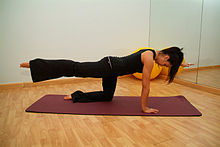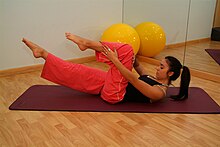Pilates
Pilates , also known as the Pilates method , is a systematic full-body workout to strengthen the muscles , primarily the pelvic floor , abdominal and back muscles . Pilates training can take place on the mat and on specially developed equipment. It was invented by the German Joseph Hubertus Pilates (1883–1967). He initially called his method Contrology , since Pilates is about controlling the muscles with the help of the mind.
Since “Pilates” is not a protected term and there is no standardized training, there are many different Pilates trainers around the world.
history
Joseph Hubertus Pilates worked as a brewery assistant as a young man. In 1912/1913 he went to England. According to his own information, he worked there with his brother Frederick as a circus artist and the two appeared as "Roman gladiators ". However, this has not been proven. Pilates then probably got by with a variety of jobs. As a German, he was interned in Great Britain at the beginning of the First World War . During this time he developed the concept of a holistic body training, which should contribute to a good condition and posture, initially for soldiers interned with him.
After his return from England, Pilates stayed in Hamburg roughly between 1920 and 1925. There he trained the Hamburg police in self-defense and also instructed various private clients. It was during this time that he began to invent the Pilates machines.
In 1926 he emigrated to the USA. With his partner and later wife Clara, whom he had met on the ship to America, he opened a training studio - at the suggestion of Rudolf von Laban in the building of the New York City Ballet , which explains the proximity of the method to dance.
In the early 1960s, many New York dancers were among their customers, which gradually gave the training method, which was once developed for men, an increasingly feminine perception.
In 1965 Joseph Pilates opened a second Pilates studio in the Henri Bendel department store in New York on West 57th Street. According to the case files for the Pilates name dispute, as long as Clara Pilates was alive, Bendel paid her a fee for running the studio. The studio was run from 1967 to 1972 by Naja Cori, who was trained by Joseph Pilates. From 1972 until the studio was closed in 1988, Kathy Grant was the director of the studio.
The decisive person in the preservation of classical Pilates, however, is Pilates' student Romana Kryzanowska , who first came into contact with Pilates around 1940 and what he himself called "Contrology", and who has worked with him since 1958. She taught until her death in 2013.
In 1967 Pilates died at the age of 84 without leaving a will or having arranged the succession and continuation of his work. During his lifetime, only two of his students opened their own Pilates studios, Bob Seed and Carola Trier, a daughter of Eduard Strauss, who had fled from Germany . In the 1990s, Pilates became a wellness trend and more and more fitness studios and other providers took up. Students who opened their own studios and developed the method further ensured that his ideas survived.
The method
Basics
The Pilates method is a holistic body training in which mainly the deep-seated, small and mostly weaker muscle groups are addressed, which should ensure a correct and healthy posture . Training includes strength exercises , stretching, and conscious breathing . It is also conditionally suitable for rehabilitation after accidents. A professional introduction to the method is important in order to avoid movement and posture errors. In general, however, the risk of injury is rather low.
The aim is to strengthen the muscles, improve stamina and coordination of movements, improve posture, stimulate the circulation and increase body awareness. The basis of all exercises is the training of the so-called “powerhouse”, which means the muscles around the spine in the middle of the body , the so-called support muscles. The muscles of the pelvic floor and the deep core muscles are specifically strengthened. All movements are carried out slowly and smoothly, which is gentle on the muscles and joints. Breathing is trained at the same time.
According to the providers, beginners should start the training with a one-to-one lesson with a classically trained trainer and then switch to equipment that supports them in performing the exercises precisely. Pilates invented the five classic devices (Reformer, Cadillac, Chair, Barrel, Spine Corrector) to support the students in performing the exercises. The widespread mat training is only recommended for advanced users . The around 500 Pilates exercises alternate between stretching and strengthening the muscles.
Important principles
The term Pilates principles was first mentioned in the first book on Pilates, The Pilates Method of Physical and Mental Conditioning , published in 1980 . Incidentally, Joseph Pilates himself did not use the word principles. So the principles are something that was later extracted from the method. The six principles were later used almost identically in other books on Pilates. The six principles that Friedman & Eisen describe are:
- Concentration
- Centering - centering
- Control - control
- Breathing - breathing
- Precision - precision
- Flow - flowing movement
Later these were often supplemented by further principles. Here is a description of the frequently mentioned principles:
control
An essential principle of training is the controlled execution of all exercises and movements. This should also strengthen the smaller "helper muscles".
concentration
With the help of concentration , body and mind should be brought into harmony. Every movement should be controlled mentally, the attention should be focused entirely on the body. In order to be able to maintain the ability to concentrate during the exercises, pilates does not use alcohol or other intoxicating substances, and there is also no background music during the training.
breathing
Conscious breathing plays an important role in Pilates. It should counteract tension and increase control over the body. That is why breathing is trained in the diaphragm .
centering
Centering means strengthening the core of the body, the so-called powerhouse , which extends from the chest to the pelvis and contains all the important organs. Strengthening the powerhouse muscles strengthens the back in particular and can have a positive effect on back pain .
Relaxation
Conscious relaxation should help to find and relieve tension. In Pilates, however, relaxation is not the opposite of body tension .
Flowing movement
All exercises are performed in flowing movements, without long interruptions. There are no abrupt, isolated movements.
Power engine, powerhouse
The term “power engine” comes from Moshé Feldenkrais . When it comes to Pilates, people speak of the “powerhouse”. This means the muscular network that provides the basic stability and control in the lumbopelvic region. This network consists of the pelvic floor muscles, transversus, multifidus, diaphragm, the muscles of the inner thighs and the muscles around the sit bones.
Posterior lateral breathing
Posterior lateral breathing facilitates bibasal expansion of the ribs. In order to master this breathing, the ribs must first be expanded and released again without using breathing to help. Inhaling and exhaling is then instinctive in response to the expansion and letting go of the ribs.
Applications
The majority of verified research into lower back and pelvic floor muscle dysfunction shows that lower back muscle problems are strongly correlated with geometric dysfunction of the deep muscle corset system (DMCS).
The DMCS is a “muscular synergy” of the transversus abdominis muscle , the deep fibers of the multifidus lumborum muscle , the diaphragm and the pelvic floor muscles. It is also called the “power engine” (power house) - the “power plant” of the body. The DMCS creates segmental stability in the pelvis and spine by preventing intervertebral (i.e., between individual vertebrae) and segmental movements of the pelvis.
criticism
It is often criticized that the term “Pilates trainer” is not protected. Numerous trainers would only have completed a weekend crash course. In fact, comprehensive training is necessary in order to learn the full Pilates training and also to gain knowledge of possible risks.
Studies
Scientific studies can be found and viewed on the NCBI website under the search term Pilates .
education
Specialists from the sports and therapy sector have the option of Pilates training or advanced training, including physiotherapists, physiotherapists, masseurs, medical pool attendants, sports therapists, trainers (A license), movement therapists, occupational therapists, qualified sports teachers, sports scientists, Rehabilitation trainer and gymnastics teacher. For the status of a prevention trainer according to § 20 SGB V, an application for the course concept at the Central Prevention Testing Center (ZPP) is necessary, which in consultation with the German Pilates Association e. V. (DPV) requires the following framework conditions: Membership in the German Pilates Association e. V. and recognition of the Pilates mat training by the ZPP requires a training of at least 60 hours of face-to-face teaching on 8 teaching days (teaching time max. 7.5 hours, plus 1.5 hours break) and 15 hours of observation. In addition, the applicant - especially a physiotherapist - must prove that he is able to lead exercise groups in a knowledgeable, competent and professional manner. This takes place in the form of a teaching qualification certificate after a teaching sample. Training is offered by physiotherapy associations and by providers specializing in Pilates training.
Web links
- Strengthening the body center (PDF; 2.4 MB) - a journalist's experience with Pilates
Individual evidence
- ^ "Hubertus Joseph Pilates - The Biography" by Esperanza Aparicio & Javier Pérez, 2013, ISBN 978-84-15409-81-6
- ^ Eva Rincke: Joseph Pilates: The man whose name became the program. Verlag Herder, 2015, ISBN 978-3-451-31295-3 .
- ↑ http://www.pilatesinsight.com/pilates/clara-pilates.aspx
- ↑ Christo Förster: They called him Uncle Joe. Retrieved March 12, 2016 . ; Arnd Krüger : history of movement therapy. In: Preventive Medicine. Springer Loseblatt Collection, Heidelberg 1999, 07.06, pp. 1–22.
- ↑ Berkshire Eagle Thursday October 21, 1965, p. 25
- ^ Leo Baeck Institute - Guide to the Papers of Carola S. Trier
- ↑ The Pilates Method of Physical and Mental Conditioning by Philip Friedman & Gail Eisen, 1980.
- ↑ Sean P. Gallaghe, Romana Kryzanowska: The Pilates Method of Body Conditioning . 1999.
- ↑ wellnissimo.de - The 7 basic principles of Pilates
- ↑ see synergist (muscle)
- ↑ malfunction of the deep muscle corset system (DMCS) ( page no longer available , search in web archives ) Info: The link was automatically marked as defective. Please check the link according to the instructions and then remove this notice. , at bodyhood.at
- ^ NCBI, search term Pilates , Retrieved November 15, 2017
- ↑ German Pilates Association e. V. (DPV) , accessed on November 15, 2017

